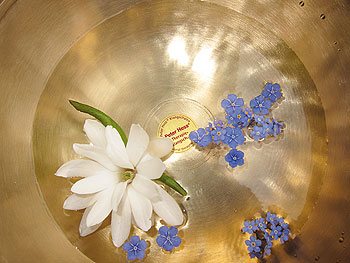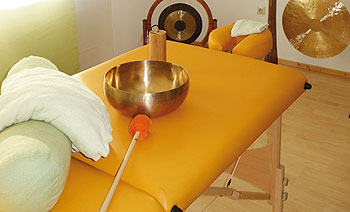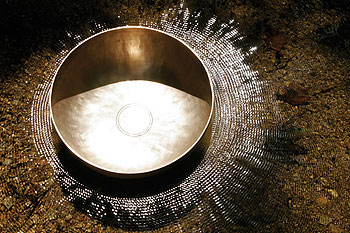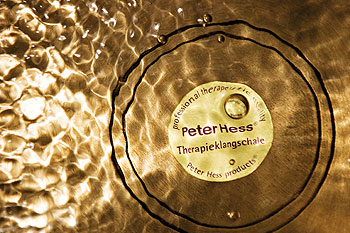from guest author Stephanie Schneider
 Through memorable experiences of accompanying patients and their relatives, I have experienced the use of sound massage as a gentle and beneficial addition to palliative care. The intense, precious moments, that I have been able to witness in the hospice accompanying people in the last phase of their life since 2014 have shown me that each sound accompaniment – with all its new challenges and gifts- is like the secret of dying itself: unique.
Through memorable experiences of accompanying patients and their relatives, I have experienced the use of sound massage as a gentle and beneficial addition to palliative care. The intense, precious moments, that I have been able to witness in the hospice accompanying people in the last phase of their life since 2014 have shown me that each sound accompaniment – with all its new challenges and gifts- is like the secret of dying itself: unique.
The sound setting – space of being
With all this uniqueness, there are some basic aspects to the sound setting that I would like to introduce here and complete with case studies.
The starting point
Almost all patients in palliative care like to get involved in the gentle method of sound massage. If a patient wishes to receive sound massage or to know more about this technique, we make an appointment. Sometimes I am also called by the team and asked if I can see a patient for a sound session as soon as possible. Sometimes it is the relatives who contact me, knowing that the patient will appreciate this method of treatment.
„Please do not disturb, sound massage, thank you!“ … says the sign that I hang on the door at the beginning of each sound session. This is an important requirement for the patient and is very well respected. Usually I start with a little preliminary talk, which also helps to build a relationship. In doing so, I allow my interlocutor to hear, feel and / or play the bowls. This way I learn something about the person, perceive him/her, his/her environment, the room, his/ her positioning. I can check if we should change anything in the positioning before the session starts or ask if the person would like to. This also enables me to see or ask if the patient is in pain now or if some further „verbal care“ is needed. I usually point out that the bowel may make some noise and that this is a good sign of relaxation. On another note, usually it is possible to find out if the patient has already experienced sound, and what he/she likes best or less, with respect to the singing bowl, sound frequency etc.
As a sound body (or carrier), the singing bowls are neutral they know no emotions. If possible, allow the patients to pick the singing bowls they like best. Often, they have a „favorite bowl“. In any case, the predominantly used pitch / tone should be perceived by the patient as pleasant as this has also been proven to have a positive effect.
„The task does not just change from person to person – according to the uniqueness of each person – but also from hour to hour, according to the uniqueness of each situation.”
(Viktor Frankl)
My intention
 The basic question that I ask myself before performing any sound experience is: “What can I offer, what is good for you and what do you want me to do to you?” The ultimate goal is for the hospice resident to relax into the sound. The sequence is punctuated by a constant, gentle tapping rhythm. The duration of the sound session is adjusted individually. Usually we allow 15 to 25 minutes. The bowls, pitch and tapping technique used vary according to the needs and symptoms, but always following the teachings of the Peter Hess ® Institute (PHI).
The basic question that I ask myself before performing any sound experience is: “What can I offer, what is good for you and what do you want me to do to you?” The ultimate goal is for the hospice resident to relax into the sound. The sequence is punctuated by a constant, gentle tapping rhythm. The duration of the sound session is adjusted individually. Usually we allow 15 to 25 minutes. The bowls, pitch and tapping technique used vary according to the needs and symptoms, but always following the teachings of the Peter Hess ® Institute (PHI).
This way, different aspects can be reconciled within a sound treatment by integrating different techniques in the sequence. Whether the bowls are sounded placed on or around the body or in the room, the results will vary given the physical situation and the contact with the patient. I observe and try to capture whether the patient needs something embracing, protective, or if he/she rather wants to be let go but in a supported way. Accordingly, I use tapping technique and my knowledge, combined with discrete observation and mindfulness.
Mindfulness is the base
The sound experience then takes place mainly silently. During the sound session, we put an emphasis on the lack of judgement. When the basic relationship is established, the receiver turns its awareness from the outside towards the inside. An inner communication takes place, a listening, or simply a sense of wellbeing being perceived as such. The inner experience is not always peaceful. Sometimes intense fears surface or inner processes take place. Therefore, being mindful of what is happening is ever so important; the giver needs to constantly monitor the vital parameters and the body signals.
When verbal or written communication is no longer possible, I look for signals like breathing, facial expression, body tension, bowel sounds, etc. This also means I need to be especially careful during the performance. Understanding and observing the patient, acting accordingly and evaluating the next step is happening all at once while playing the bowls. If needed, the giver and the receiver can agree before the treatment starts on a signal indicating the patient wishes to terminate the treatment. In that case, I have to pay special attention to the said signal – „No“ or „It‘s enough for me“ – ensure this is really what the receiver means for me to then conclude gently sound massage.
A dedicated time to experience and talk
After the treatment, I always offer the receiver some time to truly feel the experience. Most of the time when verbal communication is possible, the session is followed by a chat. Afterwards, I take the time to document the process of the sound massage on a special tracking form, including the signs observed, the sequence performed, the effects sensed, and the main observations related to the patients.
With each session, a different outcome
 Most of the time, the patient sleeps through the sound session or reaches the “threshold of consciousness” phase. The positive feedback ranges from a very relaxed facial expression to very deep gratitude. Often, pleasant sensations such as tingling, feeling the vibrations, lightness, or experiencing comfort through the entire body are described. Sometimes the patients also tell which memories, mainly in the form of images, rise within them. I was even surprised once to have someone telling me they had reminisced about some music from their childhood.
Most of the time, the patient sleeps through the sound session or reaches the “threshold of consciousness” phase. The positive feedback ranges from a very relaxed facial expression to very deep gratitude. Often, pleasant sensations such as tingling, feeling the vibrations, lightness, or experiencing comfort through the entire body are described. Sometimes the patients also tell which memories, mainly in the form of images, rise within them. I was even surprised once to have someone telling me they had reminisced about some music from their childhood.
Of course, at times people also dare to express their deepest fears, desires, fundamental questions and concerns of any kind. Depending on the situation, it is important to recognize, support, listen to and be present. By being in contact with one‘s own feelings, our inner self and from the silence experienced, one can feel a new impulse to set his house in order or provides some insight about an existential question or situation. For example, one may express the desire to see or talk with a specific person. Whether the other person fulfills this wish is another question. If necessary, a religious figure, a doctor or a psycho-oncologist can be called to further explore the subject with the patient. It is crucial to pay attention to what is important and urgent to the patient.
Whatever the situation, it is what it is
Talking specifically about palliative care, it is the utmost importance to put the needs of the client at the center of the practitioner’s preoccupation. What it means is that someone can for instance cancel a sound massage at short notice
because the neighbor unexpectedly comes to visit – perhaps for the last time. It is important to acknowledge when the patient is fully available, in the moment, to ensure the freedom and dignity of the terminally-ill person, the practitioner has to develop a higher sense of empathy and to accept the situation as it unfolds, in the moment. Because whatever the situation, it is what it is and it is fine that way.
You should be familiar with the concepts of transference and countertransference if you want to work with the sounds in this field. In the same way, the practitioner needs also to be willing to face them. The intention should always be clear. As you can see, it is simple and not at the same time. It requires knowledge, but also a certain attitude. The experiences in this work field are often very direct, very real, because of the finitude of life necessities.
What about personal belief?
So far, I only faced once the subject of what faith was about. One patient said she was a Protestant and a regularly churchgoer.
This is a clear indication of what matters to a person and which characteristics and images may play a role. I told her that I also like to go to a beautiful church service. Or just sitting silently in a church. Whether she thought that would not be tolerable. Then she sat thoughtfully smiling on the edge of the bed and we talked for a while about outdoor places, about beautiful churches etc. The interesting thing about that was that the lovely Mrs. N. had previously been deep asleep during the sound massage and seemed wonderfully relaxed and deeply touched. But this rather very different way of getting in touch with one inner self felt was somehow strange to her. It was good that she could articulate that and we could talk about it.
The experiences in this field are often very direct, very real, because the finitude of life is pressing.
Relatives also benefit from the sounds
Sometimes I am called by my colleagues who would like to benefit from all the advantage sound offers, other times, I volunteer to gift them such experience. On one occasion, I spontaneously gave a sound massage to a relative in the private room our team escapes to. She was so grateful that she also could experience the sound. It came as a great support to her in the process of letting go of her mother, at a time when she so desperately needed to do so. She described the experience as very pleasant and moving. She literally said: „That I could experience this now in this situation is a gift.“ In reality, I had come to give her mom a sound massage. Needless to say, the mother benefited anyhow of her daughter’s enjoyable experience. While the mother had slept, the daughter recharged her batteries and came back stronger than before in her mother’s bedroom. The positive results shone through.
Of course, it would be better to have an extra room on site for such situations, but at that moment it was just right. The exceptional situation of this woman was important. The location was secondary, and luckily, we did not disturb anyone that day. Just at the right time, the daughter benefitted from the rest she needed in that place.
Another time, I gave a sound massage to a patient while her relative stayed in the room. Here the sound massage ended with a wonderful peaceful smile from the patient. The daughter recognized the change in her mother‘s face and noted more positive changes. I would like to underline that it was not me who pointed out the changes to her. The daughter was moved to tears and touched. She felt comforted and talked about it. The brother, who was also in the room, remained quite skeptical about the entire experience. Before the session, I had offered him the choice to remain in the room or to leave. Daughter and mother were in the foreground. Something important has happened between them. It is very nice when these quiet moments carried by the sound, are shared and lead to a deeper encounter.
Sound for Mr. R.
Mr R. was a 40 years old patient, single, suffering from Hypopharynxca, tracheostomy, renal insufficiency, cancer cachexia,
increasing shortness of breath, COPD.
Mr. R. challenged us as a team because he required a lot of attention. Rather introvert, he was happy when we were two preparing his bed and involved him, nourishing the skin on the cachectic body, while making jokes with him. It made him smile because we approached him with humor and respect. Sometimes his condition allowed us to move him to a chair, giving him another perspective on life for a while. In a way, he clearly enjoyed being in the center of attention. Of course, he was heavily dependent on us for every aspect of his life. Sometimes he rang the bell, as soon as we left the room and we had to actually come to an agreement with him to come back at a certain time. Often, he wanted a cigarette or his cannula changed. Since he could no longer speak, he could only express himself in writing.
He also smoked in bed and sometimes agreed on small compromises: for instance, we allowed him to smoke only after the care were given and not at any other times. Most of the times, he kept busy one person of staff full time. He liked to read, preferably car, motor and sports magazines, which were often taken care of by a colleague before work. On Sundays, he received visits from his brother and wife. The mood was depressed during the visits, especially on the relative’s side. There was hardly any exchange, not even in writing. Mr. R. had however stated in one of his „writing talk“ that his relationship with his brother was a good one.
Although I hesitated to offer Mr R. a sound experience, trusting my intuition, I took the decision to explain to him that I could offer him something relaxing, and told him a little bit about singing bowls. Since Mr. R. responded positively, I introduced the idea to the team. So, one morning I came with my sound material and placed it accordingly on a sofa covered with a blanket.
 I had chosen to offer a sound bath. This is when the singing bowls are played around the patient in the room, so that the effect can be experienced first from further away. To me, that seemed more coherent and thus I carefully maintained the appropriate closeness. So, I did this, as it still seemed appropriate. After I struck a bowl close to him, so that he could directly and immediately feel and hear the vibration and the sound, I began to play the respective singing bowls in a steady rhythm. I kept eye contact all the way through the sound bath. We had agreed that he would give me a signal with his hand when he had had enough. While he spent most of the session reading, I could see he was visibly attentive to the sounds, that his breathing became calmer and that he hardly coughed anymore. After about 15 minutes I asked him if he liked the sound, because it was important for me to get a response from him. He asked for his notepad with a gesture and a death rattle and wrote the following: “It‘s alright, keep going, it‘s so relaxing.”
I had chosen to offer a sound bath. This is when the singing bowls are played around the patient in the room, so that the effect can be experienced first from further away. To me, that seemed more coherent and thus I carefully maintained the appropriate closeness. So, I did this, as it still seemed appropriate. After I struck a bowl close to him, so that he could directly and immediately feel and hear the vibration and the sound, I began to play the respective singing bowls in a steady rhythm. I kept eye contact all the way through the sound bath. We had agreed that he would give me a signal with his hand when he had had enough. While he spent most of the session reading, I could see he was visibly attentive to the sounds, that his breathing became calmer and that he hardly coughed anymore. After about 15 minutes I asked him if he liked the sound, because it was important for me to get a response from him. He asked for his notepad with a gesture and a death rattle and wrote the following: “It‘s alright, keep going, it‘s so relaxing.”
I continued playing for another 10 minutes. I, too, did enjoy very much the experience. I even spotted once a smile on his face for a short time, which somehow showed the human being in his inner original nature and with his suffering. While I only performed once for Mr. R., I knew I could have easily repeated the experience.
“Every human being has something salutary within him/ her, a spark that never fades. We cannot save anyone from the natural, inevitable, bodily death. But we can be there at every stage to increase the well-being and quality of life in the mindful dealing with ourselves and all our trusted ones. Aspects that I consider extremely important are the presence in the here and now, giving space and the motto „less is more.“
(Stephanie Schneider)
Sound for Mrs. T.
Mrs. T. was 63 years old. Diagnosis: breast cancer, bone metastases, meningitis, symptomatic epilepsy controlled with appropriate medication.
She came to us upon recommendation „Best Support Care“. Mrs. T. knew about my work with the sound. She was very happy when I offered my service. Previously, I had contacted the medical doctor to know more about the medication prescribed to her and her illness. However, it was clear that the relaxation effect and the well-being provided by the sound massage would be at the foreground of the session. So, if carefully done, there was no real contraindication. At our appointment, Ms. T told me something about her encounter with singing bowls as I prepared the sound setting. She asked me that I use fragrance, brought by her relatives, I put in the oil burner. It was a rose oil of pure quality whose scent she liked. She also loved to look at a picture brought by her relatives. It helped her to daydream she could almost escape to a green forest. It reminded her of a place she had gone with her sister many times before. It was good for her to look at this picture. She also liked to hear music. Especially the CD of a Corsican folklore band, which I played from time to time when I cared for her and that she liked.
 So, we talked about a variety of topics. Mrs. T. spoke openly about dying, without fear. She had read a lot on the subject and had made her peace with it, even mentally. She seemed almost serene, knowing, sometimes absent. She was at ease with herself despite the moments of absence or lack of coordination, which occurred at times painfully, despite the medication to prevent epileptic seizures. During this time, she needed support or for someone to handle her self-care activities. She could no longer remember the absences that became more frequent. Above all, she needed a lot of time, rest and presence. She came across as being open, sensitive and interested in others – even in the last phase of her life. She had a very good relationship with her son and sister. And her grandchildren and other relatives visited her regularly. It was nice to experience this kind of genuine care. Of course, it was also often sad because of the parting and the increasing change to be felt. This also demanded a lot from the relatives, as they had to process everything internally, and it even drove her son close to the edge. But they made the most of the time spent together, mindfully, and spoke kindly about life and its beautiful moments as well as with earlier memories.
So, we talked about a variety of topics. Mrs. T. spoke openly about dying, without fear. She had read a lot on the subject and had made her peace with it, even mentally. She seemed almost serene, knowing, sometimes absent. She was at ease with herself despite the moments of absence or lack of coordination, which occurred at times painfully, despite the medication to prevent epileptic seizures. During this time, she needed support or for someone to handle her self-care activities. She could no longer remember the absences that became more frequent. Above all, she needed a lot of time, rest and presence. She came across as being open, sensitive and interested in others – even in the last phase of her life. She had a very good relationship with her son and sister. And her grandchildren and other relatives visited her regularly. It was nice to experience this kind of genuine care. Of course, it was also often sad because of the parting and the increasing change to be felt. This also demanded a lot from the relatives, as they had to process everything internally, and it even drove her son close to the edge. But they made the most of the time spent together, mindfully, and spoke kindly about life and its beautiful moments as well as with earlier memories.
During the sound massage, Mrs. T. was particularly fond of the sound of the pelvic bowl. She felt the sound and the vibration with her hand. She liked to have this bowl struck on her stomach. She tolerated this well when asked, and was pleased with the sensation of vibration. At the beginning, I placed the rest of the bowls around the patient and struck them in a slow rhythm alternating with the pelvic bowl. Later, I placed the bowls on one hand and then the other, as I had agreed with her at the beginning. For this I used a velvet-like, small, washable pillow, which is filled with conductive beads. (This cushion can be beautifully modeled or used as base without affecting the sound vibration. That way, I do not need to change a lot the natural position of the receiver. In addition, it prevents the bowls from feeling cold on the skin. A thin cloth would be a good substitute too. In that case, I put my hand under her hand.) Now, the singing bowl was in contact and Mrs. T. and she did not need to hold to anything, which would have strained her and resulted in her hand trembling. In addition, she also felt the direct touch of the hand, which in this case was right.
On that occasion, I also placed the heart bowl on the body during the session. The heart bowl was included in turns with the pelvic bowl, and she reacted to both positively. As confirmed by Mrs. T. who felt the energy flow well and enjoyed the sound. There was no need to talk anymore. There was a subtle resonance. I finished with Koshis – chimes with seven sound bars and light resonance, which was also perceived by her as very pleasant. Previously, I had „grounded“ her with the pelvic bowl. She looked at me at the end of the sound session with an unprecedented deep and warm look. „Thank you,“ she said.
That was a very special Thank You for me. Sometimes these moments are such that I would like to share them, but in wording them, they would lose somehow their value can’t be well expressed with words.
If you are interested in other english articles, read on here…
 Stephanie Schneider is a certified nurse since 1987, as well as Peter Hess® Sound Massage Practitioner and Yoga Teacher (3HO). Since 1990, she works part-time in the field of gynecology at the SLK Klinikum in Heilbronn, Germany. As part of her advanced training in „Palliative Care“ she has dealt intensively with the topic of „sound in palliative care“ in her graduation work. Since 2014, she offers sound experiences to people and their relatives with sound in the „Hospice of the Tides“ in Bad Friedrichshall (Germany) and also runs her own practice. As a guest lecturer, she passes on her knowledge at the RKH Akademie Markgröningen about this topic.
Stephanie Schneider is a certified nurse since 1987, as well as Peter Hess® Sound Massage Practitioner and Yoga Teacher (3HO). Since 1990, she works part-time in the field of gynecology at the SLK Klinikum in Heilbronn, Germany. As part of her advanced training in „Palliative Care“ she has dealt intensively with the topic of „sound in palliative care“ in her graduation work. Since 2014, she offers sound experiences to people and their relatives with sound in the „Hospice of the Tides“ in Bad Friedrichshall (Germany) and also runs her own practice. As a guest lecturer, she passes on her knowledge at the RKH Akademie Markgröningen about this topic.
2 Gedanken zu „Sound “accompaniment” in the context of palliative care“
Vielen Dank für die Übersetzung Katrin!
Schön wenn der Beitrag Interessierten es einen veriefenden Einblick in diese Arbeit gibt.
Ich lese sehr gerne im Blog.